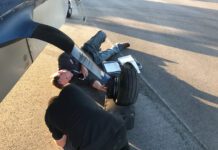I just finished reading John Goldmanfs letter to the editor in Septemberfs issue regarding Mayfs “When the Sparks Stop” article and your response that the author had not made the errors, but your editors did. Then, I read Tom Turnerfs article, “From Denial to Final, II”, where this equation is presented for best glide speed: ((W1/WG) x V), where W1 = Current Weight, WG = Maximum gross weight & V = Published V-Speed. This equation is in error. The “V” should not be under the radical but should be multiplied by the ratio of weights under the radical. The correct equation is V x (W1/WG). Variations of this equation are used to calculate best approach speed, stall speeds, etc., at different weights. Instead of applying blame, I want to be sure that a pilot does not use the incorrect formula and calculate a grossly slow speed. I suspect if one were to use the incorrect formula, the resulting ridiculously slow speed would be obvious. Mike White More Therefs an error in a formula published in Septemberfs “From Denial To Final, II” in a box with the heading “Finding Best Glide Speed.” Here are two of the ways to fix the error: The published V-speed should be taken out from the square root term: VBEST = VPUBLISHED * Sqrt(W1/Wg). Also, the published V-speed could be squared within the square root term: VBEST = Sqrt[(W1/Wg)*Vp2]. The Sqrt is intended to be replaced with the square root sign. As currently published, if the published best speed was 81 kt, and the weight was equal to full gross, the chosen approach speed would be nine knots! (Also, if one follows the units, they donft work.) Other than that, I think the article was well done. Thanks! Stephen Scott Murray Thanks, gentlemen. No excuses. Wefve reproduced the corrected formula in the box above. Speed Vs. Power I would like to comment on “Finessing Fuel” (August 2010). Most pilots know that drag force and lift increase by the square of velocity (airspeed). This is easily derived from Bernoullifs famous equations. The same equations reveal air density has a linear effect on drag and lift. The pitot-static system is affected by air density in the same way as drag and lift are, so the airplane can be flown by its indicated airspeed at any altitude. Higher altitude lowers the rate of fuel burn and increases fuel economy because air density is lower and therefore the drag force also is lower for a given true airspeed. What most pilots donft know is the horsepower requirement of the aircraft in cruise is related its velocity to the third power. Relatively small increases in airspeed require significantly large increases in horsepower. Fuel burn is similarly affected because it is directly related to horsepower. The explanation requires understanding some basic physics. Power is defined as energy per time. In this case the energy is work, so horsepower is the rate of doing work. Work is defined as force times distance. Since distance per time is velocity, the horsepower requirement is drag force times velocity. Drag force is related to velocity squared, so horsepower is related to velocity to the third power. Tim Smith Thanks, Tim, Put another way, slowing down to conserve fuel is desirable because doing so reduces our demand for power. In the bargain, drag is reduced. Reducing power by a relatively small amount results in lower airspeed. The resulting drag reduction is equal to the square of the airspeed reduction. By reducing power to slow down, we not only conserve fuel by a certain amount; we also reduce dragfs impact. At a certain speed, of course, we find VBEST ENDURANCE, below which drag increases because it requires more power to fly level.
Kennewick, Wash.
Fremont, Calif.
Walnut Creek, Calif.



